Homeostasis
1/190
There's no tags or description
Looks like no tags are added yet.
Name | Mastery | Learn | Test | Matching | Spaced |
|---|
No study sessions yet.
191 Terms
What is homeostasis?
Process of keeping the environment inside the body fairly constant (at a steady state)
What needs to be regulated?
-Core body temp
-pH and concentration of dissolved substances in body fluids
-Glucose (conc.) in the blood
-Oxygen and carbon dioxide (conc.) in blood
-Blood pressure
-(conc) of metabolic wastes
What is the negative feedback system?
(aka steady state control system) → the response is opposite to the stimulus
What are the steps to negative feedback system?
Stimulus, receptor, modulator, effector, response and feedback
What is the step of stimulus in negative feedback systems?
Change in environment that causes systems to initiate
What is the step of receptor in negative feedback systems?
Cells that detect the change
What is the step of modulator in negative feedback systems?
Control center responsible for processing information recieved from receptor, sends information to effector.
What is the step of effector in negative feedback systems?
Muscles or glands that carry out a response
What is the step of response in negative feedback systems?
Action that counters the effect of the stimulus
What is the step of feedback in negative feedback systems?
Response that is opposite to original stimulus
What is dynamic equilibrium? (feedback systems)
Any fluctuation around a normal level
What is the set point? (feedback systems)
The point around which conditions fluctuate
What are tolerance limits? (feedback systems)
Upper and lower limit to a range of factors
Body functions normally in those limits
Anything outside normal range usually leads to dysfunctions
What is the positive feedback system?
No role in homeostasis
- Response to a stimulus and reinforces and intensifies the stimulus
Important in controlling processes that must be completed quickly
What is an example of a positive feedback system?
Increased oxytocin levels during labour and blood clotting
What is thermoregulation?
-Regulation of body temperature around 36.8C
Most heat produced through metabolic activity
Heat gained must equal that heat is lost
What is thermoregulation important?
Chemical reactions in cells are heat sensitive → (too cold reactions occur to slowly and if it was too hot then enyzmes denature
What is the process of heat production?
-Cellular respiration
-60% of released energy is heat
-The rate at which energy is released by the breakdown of food is referred as the metabolic rate.
- Can be increased by exercise, stress, rising body temp
What are the two types of temperature receptors?
Peripheral and central
What are peripheral thermoreceptors?
-Located in the skin and some mucous membranes
- Provides hypothalamus with info about external environment
What do Heat and Cold peripheral thermoreceptors do?
Cold receptors trigger heat conservation/ production from hypothalamus
Heat receptors trigger heat loss/ reduction from hypothalamus
What are central thermoreceptors?
Located in the hypothalamus → (detects temp changes in internal)
-Controls activities that help to either increase or decrease body temp
What are the methods of heat transfer?
Conduction, convection, radiation and evaporation
What is the method of conduction in heat transfer?
This is heat loss though direct contact between particles
-Sitting on a cold/hot surface
-Being submerged in cold water
What is the method of convection in heat transfer?
Loss of heat through moving air or liquid
-Cold are blowing
What is the method of radiation in heat transfer?
Heat loss through the emission of electromagnetic radiation
- Body heat being lost to the “environment”
What is the method of evaporation in heat transfer?
When heat is lost when a liquid turns into a gas → which absorbs heat energy
-Sweating
What is the skins role in thermoregulation?
-Changes in skin structures can increase/decrease rate of heat lost from body
- Blood vessels carry heat to skin from core of body → this heat dan then be lost from skin by convection or radiation
→ Diameter of blood vessels controlled by autonomic nerves from the medulla oblongata → can inc/dec the flow of blood near surface via vasodilation or constriction
When vessels at max dilation, but more heat required to be lost → sweating occurs
What is the definition of sweat?
Secretion of fluid by sweat glands plus the periodic contraction of cells surround the ducts to pump to surface
What does sweat consist of?
Water that contains dissolved substances (mostly NaCl) some urea, lactic acid and potassium acids
What is sweats role in thermoregulation
Evaporation of sweat → cooling effect
-Heat removed from skin when liquid changes to vapour
-Cooling of skin = cooling of blood flowing through skin → cooling of body temp
-Stimulated by sympathetic nerves
How does the body prevent the body temperature from falling
Cold receptors in skin send messages to hypothalamus → impulses for reducing heat loss and increasing heat production
-Body can respond by physiological changes or behavioural changes
What are physiological changes to the body in cold temperatures?
Vasoconstriction, shivering, stimulation and increase of thyroxine
What is the physiological change of vasoconstriction in cold temps in the body
Hypothalamus stimulate sympathetic nerves for blood vessels in skin to contract
- Decreases flow of warm blood to skin from internal organs
-Decreases heat loss from body surface
What is the physiological change of shivering to the body in cold temp
Hypothalamus sends stimuli to parts of brains that increase skeletal muscle tone
-Leads to oscillating (rhythmic muscle tremors) at a rate of 10-20 per second
-Increases body heat production as the cells perform cell respiration as they oscillate
- Whilst being controlled by the hypothalamus we can consciously stop shivering through cerebral cortex.
What is the physiological change of stimulation to the body in cold temp
Stimulation of adrenal medulla via sympathetic nerves → increases secretion of adrenaline and noradrenaline into blood
- Increases cellular metabolism → increase heat production
What is the physiological change of increase of thyroxine to the body in cold temp
Increase in production of thyroxine → hypothalamus causes anterior pituitary to secrete TSH → thyroid glands releases thyroxine in blood
-Increases thyroxine levels = increase metabolic rate = increase body temp
-Slower to have effect but longer lasting
What are behavioural changes to cold temps
-Putting on an extra jumper
-Sheltering from cold wind
-Reducing surface area of body where heat can be lost (curling into a ball)
How does the body prevent body temp from rising
Excess heat needs to be lost from body
Most heat loss occurs through skin
Small amounts of heat are lost when gases are breathed out and with faeces and urine
What is the physiological changes in the body to hot temps?
Vasodilation, Sweating, Decreased Thyroxine
What is the physiological change of vasodilation to the body in hot temps
Increases blood flow through the skin
- Becomes red in colour because of more flood close to surface , surface temp rises and greater heat loss through radiation and convection
What is the physiological change of sweating to the body in hot temps
Increases heat loss through body through evaporation
- Cooling effect only works in environments that are dry
-if air is humid sweat cannot evaporate
What is the physiological change of decreased thyroxine to the body in hot temps
Decreased secretion of thyroxine → decreases metabolic rate → decreases amount of heat produced in the body
-long term effect
What are behavioural responses to hot temps
Turning a fan or aircon on
Removing external clothes
Reducing physical activity
seeking shade
Drinking a cold drink
negative feed back loop (im too cold )
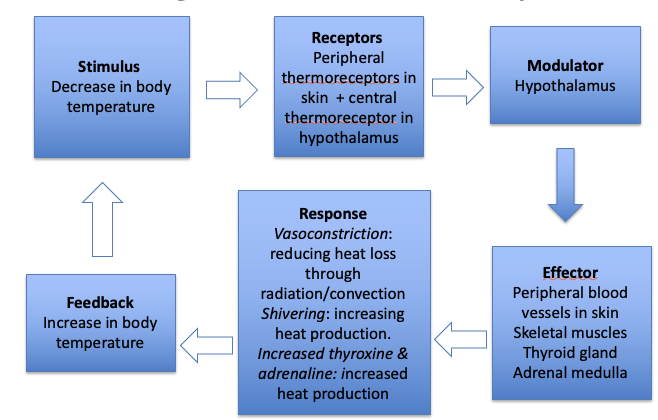
negative feedback loop ( too hot help )
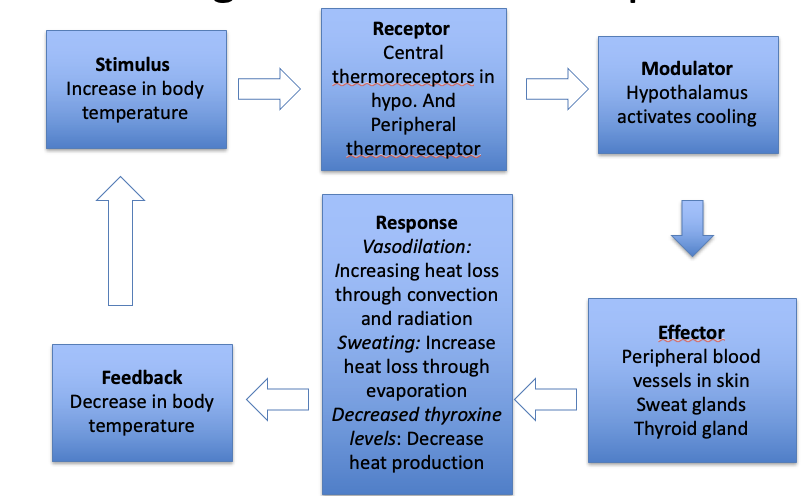
What is temperature tolerance?
In extremely hot conditions
- Heat exhaustion
Heat stroke
Cold conditions (when body temps is below 33c)
Hypothermia
What is heat exhaustion
Extreme sweating and vasodilation
-Loss of water in sweating reduces volume of blood plasma, vasodilation reduces resistance to blood flow → blood pressure decreases and person may collapse
-Body temperature only slightly elevated
What is heat stroke?
In hot and humid conditions
-It is difficult for the body to lose heat → causign core body temp to rise and regulatory mechanisms to stop sweating and vasodilating
→ Can be fatal
what is heat stroke treatment?
Cooling body quickly by immersing patient in cold water placing cold packs in places with main blood vessels (neck groin and armpits
What is hypothermia?
When body is unable to replace the heat lost due to a low metabolic rate
- ts not in the syallabus bro
What is glucose?
Main source of energy for cell activity (cell respiration)
How is blood sugar regulated?
Carbohydrates broken down into glucose
After eating blood glucose conc. can increase dramatically
After exercise / periods of fasting → they can decrease
Glucose levels regulated by either removing it/ storing it or releasing it and creating it
What and where can glucose be stored?
Glucose can be stored as glycogen (long chains of glucose molecules) in liver and skeletal muscle cells
What is the role of the liver in regulation of blood sugar? (glucose conversion)
Liver converts glucose → glycogen for storage or glycogen → glucose to be released into the bloodstream
Where does most of the livers blood supply come from?
Comes from the hepatic portal vein → brings blood directly from stomach, spleen , pancreas and small / large intestines
(This means liver has first chance to absorb nutrients from digested food)
What is the role of the liver in regulation of blood sugar? (absorption of glucose)
Glucose is absorbed into the blood capillaries of the villi in small intestine, hepatic portal veins carries glucose to liver.
-Glucose can be removed from blood to provide energy for liver functioning
- Can be removed by the liver / muscles by converting it into glycogen
- Can continue to circulate in the blood, available for body cells to absorb
- Excess glucose can be converted into fat for long term storage (lipogenesis)
What is glycogenesis?
Occurs in the liver
- Conversion of glucose to glycogen and is stimulated by insulin
What is glycogenolysis?
If more glucose is required glycogen can be converted back to glucose
- stimulated by glucagon
What is the role of the pancreas in blood sugar regulation?
Within pancreas, clusters of hormone secreting cells called Islet of Langerhans
Made up of two cells types
- Alpha and Beta cells which both secret hormones into the bloodstream
what do alpha cells secrete
glucagon (remember as alpha secrete glucagon) )
what do beta cells secrete
insulin
What is the role of insulin in the regulation of blood sugar levels
Decreases blood sugar levels in two main ways
- Accelerates uptake of glucose from blood into cells (especially skeletal muscle) so that it can be used for cell respiration
- Accelerates conversion of glucose into glycogen (glycogenesis) in liver and skeletal muscles
(also stimulates conversion of glucose into fat in adipose tissue and an increase in protein synthesis in some cells)
What is the role of glucagon in the regulation of blood sugar levels
Causes an increase in blood sugar level
- Stimulates glycogenolysis (break down of glycogen in liver)
- Stimulates liver to produce glucose molecules from non - carb substrates such as lipids and amino acids (gluconeogenesis)
- May also have a mild stimulating effect on protein breakdown
What is the role of the adrenal glands in the regulation of blood sugar levels? (cortex(
When low levels detected by the hypothalamus
- Adrenal cortex secretes glucocorticoids (cortisol is the best known one)
Gets stimulated by adrenocorticotropic hormone (ACTH) from anterior pituitary lobe
- Regulates carbohydrate metabolism via glycogenolysis
- Increases the rate of amino acids being removed from muscles cells / adipose tissue and transported to liver → to be made into glucose (gluconeogenesis)
What is the role of the adrenal glands in the regulation of blood sugar levels? (stress)
During periods of stress
Adrenal Medulla secretes adrenaline and noradrenaline
- Adrenaline promotes glycogenolysis
-Stimulates production of lactic acid from muscles cells can then be used by liver to make glucose (gluconeogenesis)
- Inhibits insulin activity - less glucose taken up by cells
Negative feedback loop (high sugar levels) regulation of blood sugar levels
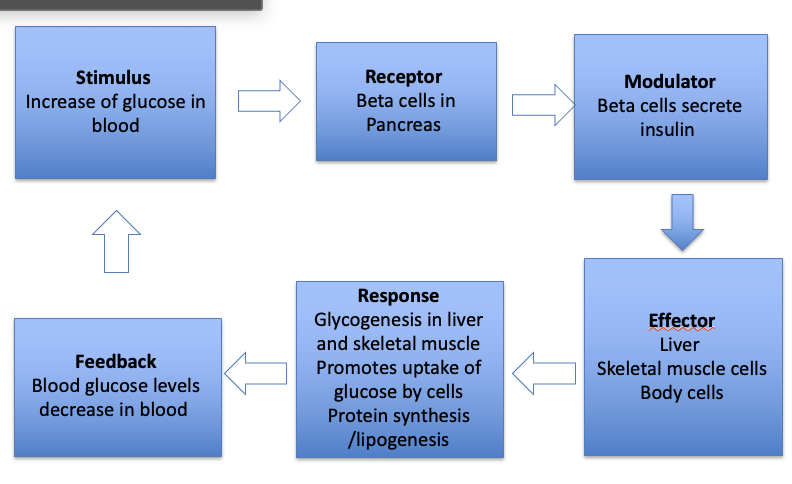
Negative feedback loop (low sugar levels) regulation of blood sugar levels
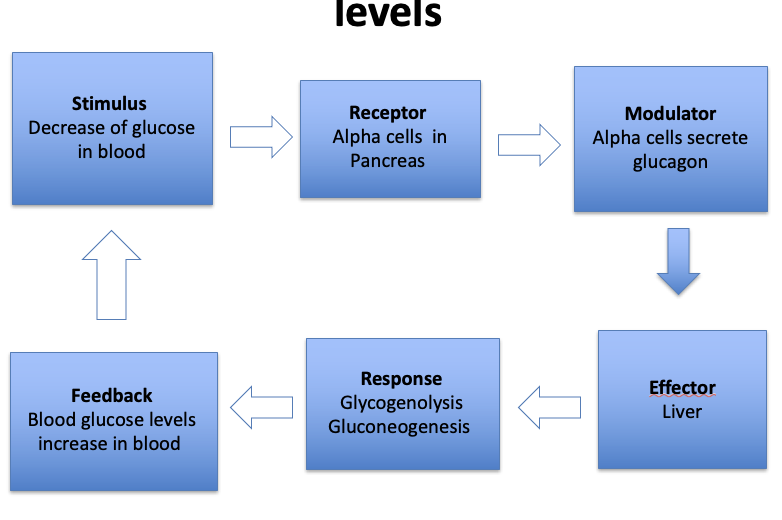
What is the water percentage contained in various body fluids in the human body?
60% water [varies 45-75%]
What is Intracellular fluid?
fluid inside the cell (cytosol)
What is Extracellular fluid?
fluid outside cells (includes blood plasma, and fluid between cells [aka intercellular/interstital fluid])
What are the types, proportions and components of those body fluids?
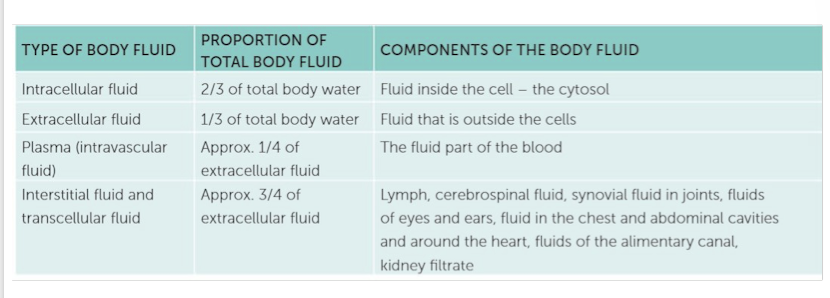
what is fluid balance?
fluid gain = fluid loss
most body fluid is obtained from water from food/drink
small amount produced by cellular respiration (referred to as metabolic water)
fluid is lost via kidneys, skin, surface of lungs and alimentary canal
What is Excretion?
Removal of metabolic waste products from the body
How do the lungs contribute to excretion?
excretion of carbon dioxide
water also lost in the form of water vapour during exhalation
How do sweat glands contribute to excretion?
secretes water containing byproducts of metabolism (salts, urea, lactic acid)
How does the alimentary canal contribute to excretion?
passes out bile pigments (breakdown products of haemoglobin
How do the kidneys contribute to excretion?
maintains constant concentration of materials in body fluids
What are the kidneys?
located on either side of the vertebral column
held in position by mass of fatty tissue
ureter leaves each kidney and drains into a muscular reservoir (bladder), empties to outside through urethra
each kidney contains 1.2 million nephrons
How does the kidneys control water loss?
-Volume/ composition of urine produced by kidneys depends on how much water there is in body fluids
-Approximately 99% of water filtered through nephrons is reabsorbed
-Reabsorption at PCT and LOH done via osmosis
-Reabsorption at DCT and collecting ducts done via active reabsorption and it is controlled by anti diuretic hormone (adh)
How is water intake regulated?
As water is lost from various body fluids, a reduction is plasma volume occur and an increase in osmotic concentration occurs in the extracellular fluid
What is antidiuretic hormone?
Produced by the hypothalamus
Released from the posterior pituitary lobe
- Controls the permeability of walls of DCT and collecting duct to water
What happens if there is high ADH levels?
More permeable and more water absorbed
what happens if there is low ADH levels?
less permeable and less water reabsorbed
what is the negative feedback loop for low fluid levels
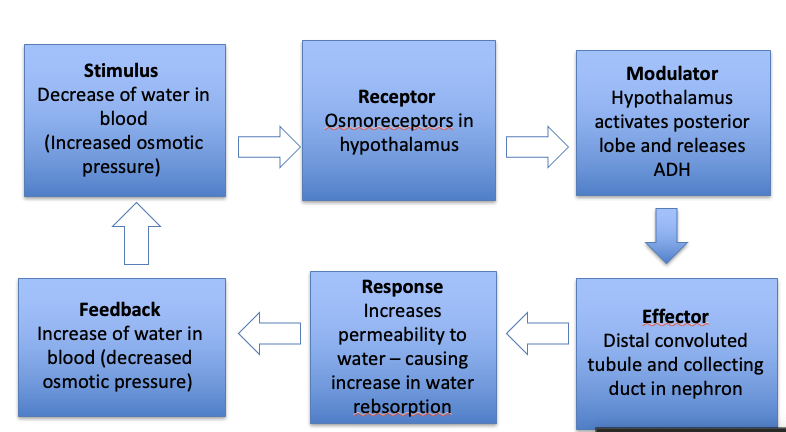
what is the negative feedback loop for high fluid levels

What is aldosterone?
-Also plays a part in regulation of water output
- Secreted by adrenal cortex
- Acts on kidney tubules to increase amount of sodium reabsorbed into bloodstream
-Also increases amount of potassium excreted into urine
- Due to osmosis water is also reabsorbed along with sodium ( why it has a role in regulating water in the body)
what is the thirst reflex
When blood osmolarity increases (less fluid in blood) it triggers a behavioural response → an urge to drink fluids
What are the changes in osmolarity are detected by?
Detected by osmoreceptors in the hypothalamus which communicate with other regions in the brain eg pre frontal cortex producing the conscious desire to drink water or other fluid
What is the negative feedback loop for low fluid levels (behavioural response)

What is dehydration?
when water less exceeds water intake
wat r the symptoms of dehydration
Severe thirst , low blood pressure
Noticed when 2% of normal body water is lost (by sweating, diarrohea)
If not treated, patient can become delirious, lose consciousness and die
What is water intoxication?
Occurs when body fluids become diluted and cells take in extra water by osmosis
- May happen if person loses a lot of water and salts through sweating and replaces loss with plain water (osmotic balance is disrupted as no salt in plain water)
- Also secondary to psychological disorders and drug interactions
what is the symptoms of water intoxication
light headedness, headache, vomiting and they usually collapse.
How are gas concentrations regulated?
Since all cells need oxygen and produce carbon dioxide
→ Lungs exchange carbon dioxide and oxygen between blood and air
→ Changes in breathing change amount of oxygen in / carbon dio excreted
→ Circulatory system involved
How is breathing controlled?
Diaphragm / intercostal muscles are skeletal muscle → require stimulation from nerve impulses to initiate contraction
Originates in the spinal cord in neck / thorax
In the control of breathing what is the diaphragm stimulated by
phrenic nerve
In the control of breathing what is the intercostal muscles stimulated by ??????????
Intercostal nerves
In the control of breathing what are nerve impulses controlled by
Nerve impulses are controlled by respiratory centre located in medulla oblongata
→ Messages need to pass back / forth between the neurons in these two regions to keep it coordinated